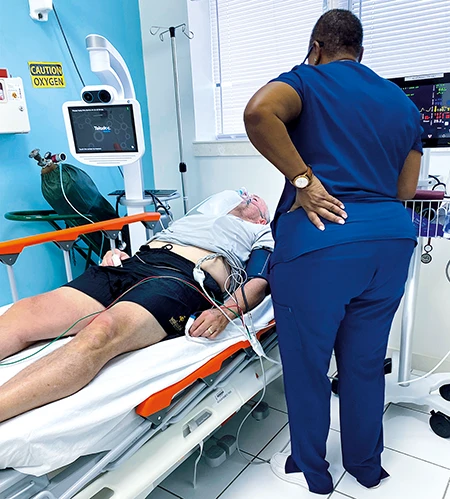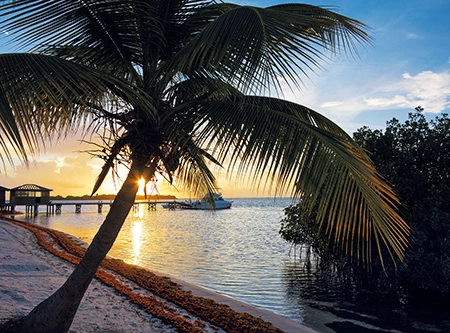I am grateful for the safety information DAN publishes, their recommendations for dive medicine physicians, and the peace of mind their insurance coverage provides. My wife, Julie, and I have had DAN insurance for many years and are fortunate to have called DAN in an emergency only one time, 13 years ago when a lionfish stung Julie. Our diving had been without any incidents aside from that, but our last trip to Little Cayman was different.
Julie and I are dive buddies and open-water divers with more than 800 dives. We live in Denver, Colorado, but are fortunate to have traveled and dived in world-class locations. Some dives have been challenging, with significant currents or chilly temperatures.
Our goal is usually to take two dive trips a year — one to somewhere far away or challenging, such as Raja Ampat, and one to the Caribbean. We particularly love Little Cayman for its relative ease, chill vibe, spectacular reefs, and fantastic Bloody Bay Wall. In May 2024 we departed snowy Denver to dive for a couple of weeks in the warmth and beauty of Little Cayman.
We planned to take advantage of the pristine conditions with three dives a day, all no-decompression dives on nitrox with appropriate safety stops and surface intervals. A typical day was a morning boat trip for two dives, returning to the dock for lunch, and then an afternoon dive.
The first dive each day would be the deepest but well within the limits, with slow ascents and a final safety stop before surfacing. After spending a one-hour surface interval traveling to a second site and enjoying snacks and hydration, we would do the next dive. The third dive would be after a two- or two-and-a-half-hour surface interval, and then we’d spend the rest of the afternoon relaxing before having an early dinner and bedtime.
We always made sure to stay hydrated, and our saturation and oxygen levels had been fine. We had no problems until the ninth day of diving. That morning was normal, with a first dive to 85 feet (26 meters) for one minute at maximum depth. The second dive took us to 60 feet (18.3 m), but we spent most of it over the reef at about 20 feet (6 m). After lunch we had one of the most amazing dives of our lives, enjoying an amazing interaction with Caribbean lobsters on a sandy expanse at 47 feet (14.3 m), our maximum depth, accompanied by our divemaster. A beautiful eagle ray was also feeding there, and we spent 15 minutes gently following and observing it before it moved on.

We made an appropriate ascent to a three-minute safety stop along the mooring line at 15 feet (4.6 m), after which I returned to the boat to urinate. Julie and the divemaster followed shortly afterward, and then we headed for the dock.
About 10 minutes after boarding the boat, I began to experience muscular pain in my lower chest, my right leg lost motor function, and I knew I was in trouble. Our divemaster immediately started me on oxygen, radioed for help, and got us to the dock in record time. They took me to the island’s clinic, where a very knowledgeable nurse continued my oxygen, took my vitals, ran an electrocardiogram, and asked about my symptoms. She was in constant contact with DAN and a doctor on Cayman Brac. The DAN physician guided me and the nurse through the acute stages of treatment for decompression sickness (DCS), helped me decide about my care, and provided a much-needed resource with deep knowledge about DCS.
The treatment quickly resolved my symptoms: The chest pain went away, and I regained control of my leg. Both the DAN physician and the nurse insisted that I continue oxygen therapy for another four hours. With my diving over for this trip, I returned to the clinic the next morning for a follow-up. I insisted that Julie continue diving while I relaxed and read until we left the island three days later.
DAN stayed in contact throughout the trip and was responsive and helpful over numerous calls and emails. After returning home, I visited a DAN-recommended dive physician for a full dive fitness evaluation and was cleared to resume diving. The support from DAN didn’t end there, as they continued to answer my questions and provide guidance as I planned my next dive.
In all my years of diving I had never experienced DCS before that episode, and I hope I never experience it again. We did everything right with our profiles, offgassing, hydration, and rest. Julie and I have dived in more strenuous conditions without having any incidents and never had any red flags on previous dives. We couldn’t point to a specific cause, but after consulting with DAN and the dive physician, we plan to adjust future trips to have full days off during multiweek dive trips and think about how we can dive even more conservatively.
Having DAN on my side as a ready resource made this experience so much better than it could have been. I am extremely grateful to DAN for their professionalism, responsiveness, and high level of competence and skill.

We have always purchased DAN dive accident insurance, and I was especially grateful we had it when we needed help. DAN was certainly there for us, and it made all the difference.
© Alert Diver – Q3 2024